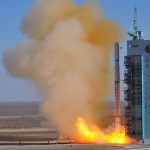The Pakistan Armed Forces’ Strategic Plans Division (SPD) is preparing to launch two satellites in June 2018 – the Pakistan Remote Sensing Satellite (PRSS-1) and the Pakistan Technology Evaluation Satellite (PakTES-1A). The satellites will ride piggy-back on the Long March 2C launch vehicle from the Taiyuan Satellite Launch Centre [1].
The launch has techno-political intricacies and implications. The PRSS-1 is built by the China Great Wall Industry Corporation (CGWIC), an arm of the China Aerospace Science and Technology Corporation (CASC), which is Beijing’s prime state-controlled space contractor. The Space and Upper Atmosphere Research Commission (SUPARCO) claims that the PRSS-1 will be vital for mapping agricultural yield, disaster and environmental mitigation and urban and rural lands. But deployment of the satellite may have military applications as well. The Space Frequency Coordination Group (SFCG), a collegium of space agencies that oversees the allocation of radio frequencies for satellite operations, has said that the carrier frequency of PRSS-1 – 8.2 GHz [2] – is part of the X-band (8.0-12.0 GHz) region of the electromagnetic spectrum, which is usually used for beyond-the-line-of-sight satellite communications to connect mobile platforms, such as unmanned aerial vehicles, aircraft, ships and ground forces. Also, the PRSS-1 is believed to carry two high-resolution payloads. One might be a synthetic-aperture radar (SAR), which is used for all-weather, day-and-night, and terrestrial and marine imagery (IMINT) and geospatial intelligence (GEOINT). The other is an electro-optical (EO) imaging system, which has tactical command, control, communications, computing, intelligence, surveillance, and reconnaissance (C4ISR) applications [3].
The PRSS-1 is very likely another in the series of the Chinese Yaogan C4ISR satellites, which are manufactured by the CASC consortium, and carry payloads, such as SAR and EO. Beijing is intending to lease a Yaogan to Islamabad to militarily engage New Delhi from its western front and simultaneously monitor the multi-billion-dollar infrastructure investments it has made in Pakistan.
The SPD is taking small steps towards indigenising and modifying its space policy. Its space programme is spread between multiple agencies – the Defence Science and Technology Organisation (DESTO), Khan Research Laboratories (KRL), National Engineering and Scientific Commission (NESCOM), and SUPARCO. This institutional balkanisation and Islamabad’s swinging relations with the United States and China, have kept the space programme reliant on powerful international partners [4]. While currently dependent on Beijing, the SPD is now seeking less dominating partners. For instance, the PakTES-1A, apparently an indigenously built satellite, has a multispectral camera payload provided by the South Africa-based Space Advisory Company [5].
While Islamabad’s increasingly close relations with Beijing and its adventurous geopolitical manoeuvres have undermined its relations with the U.S. – most SPD subsidiaries have been sanctioned by the U.S. Bureau of Industry and Security (BIS) since the Pakistani nuclear tests of 1998 – SUPARCO continues to obtain prohibited technologies on the international market including from U.S. suppliers. In August 2014 it obtained a Large Area Pulsed Solar Simulator (LAPSS), from Spectrolab, a wholly-owned subsidiary of the U.S. aerospace company, Boeing [6].
It is now becoming clear what SUPARCO gained from this illicit import. To date, Islamabad has the know-how to build very small ‘cube’ satellites; it launched its first such indigenously-built satellite – iCUBE-1 – in November 2013 on a Russian Dnepr launch vehicle [7]. Constructing larger satellites requires state-of-the-art laboratory infrastructure and better equipment than is needed for building cube satellites. The LAPSS can simulate the entire electromagnetic spectrum of solar illumination that is needed for testing prototypes of larger satellites like the PakTES-1A.
Despite having a benefactor in Beijing, the SPD comprehends that Beijing may provide it technologies solely for its own pursuits in South Asia, not for altruistic reasons. That explains why, with PakTES-1A, the SPD has taken up capacity-building in the space sector by itself, often resorting to the clandestine proliferation tactics it has used to build its atomic programme.
The SPD has begun to realise the consequence of its technology gap with India and the world. It now wants to invest in scientific research and development, emulating its strategic partners in West Asia. New Delhi must welcome and support all attempts for peaceful progress in South Asia, but it must also avert military surprises and prepare to offset any attempts at C4ISR-driven warfare.
Chaitanya Giri is Fellow, Space and Ocean Studies, Gateway House.
Click here to view our repository on the Arc of India’s Border Security.
This article was exclusively written for Gateway House: Indian Council on Global Relations. You can read more exclusive content here.
For interview requests with the author, or for permission to republish, please contact outreach@gatewayhouse.in or 022 22023371.
© Copyright 2018 Gateway House: Indian Council on Global Relations. All rights reserved. Any unauthorized copying or reproduction is strictly prohibited.
References
[1] Bilal Khan, ‘Pak signs new satellite contract with China (CGWIC)’, Quwa Defence News and Analysis Group, 27 March 2018, <https://quwa.org/2018/03/27/pakistan-signs-new-satellite-contract-with-china-cgwic/>
[2] Retrieved from the X-band database on the Space Frequency Coordination Group website, <https://www.sfcgonline.org/home.aspx>
[3] Bilal Khan, ‘Pakistan affirms plans to deploy Earth-observation satellite in 2018’, Quwa Defence News and Analysis Group, 5 October 2017, <https://quwa.org/2017/10/05/pakistan-affirms-plans-to-deploy-earth-observation-satellite-in-2018/>
[4] In the glory days of its relation with the western-bloc, the SPD enjoyed numerous collaborations. Islamabad’s first satellite Badr-A, an amateur radio satellite launched in 1990, resulted from a technology transfer and personnel training from the United Kingdom-based University of Surrey. Launched in 2002, the Badr-B was another collaborative product of the UK-based Space Innovations Limited and the Rutherford Appleton Laboratory and the Chaklala-based DESTO. Islamabad also was able to lease a communication satellite – PAKsat-1E –from the United States-based satellite communication services company Hughes Communications.
[5] ‘China to launch two remote sensing satellites for Pakistan in June’, GB Times, 24 May 2018, <https://gbtimes.com/china-to-launch-two-remote-sensing-satellites-for-pakistan-in-june>
[6] Retrieved from the Bureau of Industry and Security, United States Department of Commerce website, <https://efoia.bis.doc.gov/index.php/documents/export-violations/export-violations-2015/1075-e2472/file>
[7] Retrieved from the Institute of Space Technology-Islamabad website, <http://www.ist.edu.pk/news/2013/icube-1-launch>


